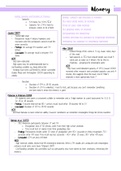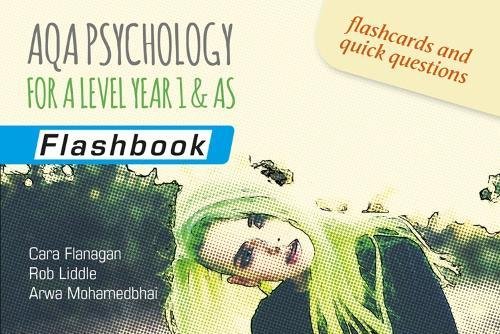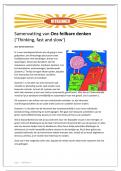Memory
Coding, Capacity and Duration of Memory:
Coding, capacity and duration of memory
- Capacity
o 5-9 items for STM (7∓2) The multi store model of memory
o Capacity for LTM is hard to Types of long-term memory
measure, seems to be infinite.
The working model of memory
Jacobs (1887) Explanations for forgetting
- Tested digit span
- Researcher reads 4 letters/numbers and Factors affecting the accuracy of eyewitness testimony
increases until the participant cannot recall the Improving the accuracy of eyewitness testimony
order correctly.
- Findings: On average 9.3 numbers and 7.3
Miller (1956)
letters
- Noticed things often come in 7s e.g., music notes, days
- Concluded: On average recall is between 5-9
of the week.
items.
- Said capacity is 7∓2 but noticed people can recall 5
AO3:
words just as easily as 5 letters. We do this by
+ Has been replicated
chunking – grouping into meaningful units.
- Digit spans may be underestimated due to
AO3:
confounding variables e.g., being distracted
- May have overestimated capacity of STM, Cowan (2001)
+ Findings have been confirmed by better controlled
reviewed other research and concluded capacity was only 4
studies (Bopp and Verhaeghen 2005) supporting its
chunks, this suggests that the lower end of Miller’s
validity.
estimate is more appropriate than 7.
- Duration
o Duration of STM is 18-30 seconds
o Duration of LTM is unlimited, - hard to test, just because you can’t remember something
one time doesn’t mean the memory is gone.
Peterson & Peterson (1959)
- 24 students were given a consonant syllable to remember and a 3-digit number to count backwards for 3, 6, 9,
12, 15 or 18 seconds.
- Findings: 3 second interval had 80% correct recall, recall after 18 seconds fell to 3%.
- Concluded: Duration of STM is 18-30 seconds
AO3:
- Artificial stimulus so lacks external validity, however sometimes we remember meaningless things like phone numbers.
Bahrick et al. (1975)
- 392 American participants between 17 and 74.
o Recognition test of 50 photos, some from their high school yearbook.
o Free recall test of names from their graduating class.
- Findings: Participants tested within 15 years of graduation were 90% accurate in photo recognition. 70%
accurate after 48 years. Free recall was less accurate – 60% after 15 years, 30% after 48 years.
- Concluded: LTM can last a lifetime
AO3:
+ High external validity tested real-life meaningful memories. When LTM studies are conducted with meaningless
pictures recall rates were lower (Shepard 1967).
- Confounding variables not controlled, such as participants may have looked at their yearbooks, rehearsing the
memory.
, - Coding
o STM is coded acoustically
o LTM is coded semantically
Baddeley (1966a, 1966b)
- 4 groups were given 4 different lists to remember: acoustically similar, acoustically
dissimilar, semantically similar, semantically dissimilar
- Findings: Immediate recall worse with acoustically similar words. Recall after 20 minutes
worse with semantically similar words.
- Concluded: STM is acoustic, LTM is semantic
AO3:
+ Identified a clear difference between the 2 memory stores.
- Artificial stimuli, when processing more meaningful information people may use semantic
coding for STM tasks – limited application, should be cautious about generalising it
The Multi-Store Model of Memory:
- Atkinson & Shiffrin (1968) multi-store model describes
how information flows through the memory system.
Memory is made of three stores linked by processing.
- Assumptions of the MSM
o There are separate stores for memory.
o Each store has different limits/constraints
including capacity, duration and encoding.
o STM is a single store.
o There is only one kind of rehearsal
(maintenance rehearsal) – if we repeat items
enough times, they will enter our LTM.
o All info must pass through STM first before reaching LTM. We do not use LTM to process
items in STM – forced sequencing.
o All memories are processed in the same way.
- Parts of the MSM:
1. Sensory Resister
- A stimulus from the environment will pass into the sensory registers along with other sights
sounds, smells etc.
- The two main stores in the sensory register are called iconic memory (visual) and echoic
memory (auditory).
- The sensory registers have a high capacity e.g., over one hundred million cells in each eye
storing data.
- Duration is less than half a second
- Very little of what goes into the sensory register passes into the memory system.
- If a person’s attention is focused on a sensory store, then the data is transferred to STM.
2. Short-Term Memory
- Information is held in STM for immediate tasks. It has limited duration (30 seconds).
- Capacity of STM between 5 and 9 items, due to this information will disappear if new
information displaces it.
- Coded acoustically
- Information is kept in STM as long as we rehearse it. Maintenance rehearsal occurs when we
repeat material over and over. This repetition will create a new long-term memory.
3. Long-Term Memory






